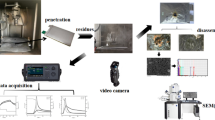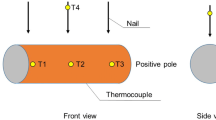Abstract
The nail penetration test on lithium-ion cells with a tungsten steel nail can cause significant heat sinking to the nail. In this work, a polyformaldehyde nail with both low thermal conductivity and low electrical conductivity is proposed to conduct the nail penetration test to study the thermal response. Meanwhile, a 3D electrochemical–thermal model is developed to predict the thermal behavior of lithium-ion cells during nail penetration tests. Two typical modes (recovery mode and non-recovery mode) of voltage response are observed and illustrated in polyformaldehyde nail penetration tests. The present results demonstrate that Al–Cu short dominants the four internal short-circuit modes in polyformaldehyde nail penetration tests. It can be concluded that net heat absorbed by the cell in polyformaldehyde nail penetration modeling is more than that in tungsten steel nail penetration modeling, causing the higher temperature rise of lithium-ion cell in nail penetration tests with the tungsten steel nail than that of polyformaldehyde nail. The present study provides an ideal alternative to solve the heat sinking to the nail in the nail penetration tests effectively.













Similar content being viewed by others
Abbreviations
- c :
-
Volume-averaged lithium concentration in a phase (mol m−3)
- \(C_{\text{p}}\) :
-
Specific heat capacity (J kg−1 K−1)
- D s :
-
Li diffusion coefficient in a solid (m2 s−1)
- d nail :
-
Nail diameter (m)
- \(E_{\text{act}}\) :
-
Activation energy (J mol−1)
- j :
-
Volumetric reaction current (A m−3)
- \(L_{\text{nail}}\) :
-
Length of penetrated nail (m)
- \(q_{\text{rev}}\) :
-
Reversible entropic heat generation rate (W m−3)
- \(q_{\text{ohm}}\) :
-
Ohmic heat generation rate (W m−3)
- \(q_{\text{act}}\) :
-
Activation heat generation rate (W m−3)
- \(R_{\text{st}}\) :
-
Shorting resistance (\({{\Omega }}\))
- \(r_{\text{s}}\) :
-
Radius of solid active material particles (m)
- T :
-
Absolute temperature (°C)
- t :
-
Time (s)
- \(U\) :
-
Open-circuit voltage (V)
- \(\alpha_{\text{a}}\) :
-
Anodic transfer coefficient
- \(\alpha_{\text{c}}\) :
-
Cathodic transfer coefficient
- \(\varepsilon\) :
-
Surface emissivity
- \(\varepsilon_{\text{e}}\) :
-
Volume fraction of a phase
- \(\kappa\) :
-
Ionic conductivity of electrolyte (S m−1)
- \(\kappa_{\text{D}}\) :
-
Diffusional conductivity of a species (A m−1)
- ρ :
-
Density (kg m−3)
- σ :
-
Electronic conductivity (S m−1)
- \(\phi\) :
-
Electrical potential in a phase (V)
- \(\varPhi\) :
-
Generic physiochemical property
- 0:
-
Initial value
- e:
-
Electrolyte phase
- max:
-
Maximum value
- ref:
-
With respect to a reference state
- s:
-
Solid phase
- eff:
-
Effective
- Li:
-
Lithium species
References
Balakrishnan PG, Ramesh R, Prem Kumar T. Safety mechanisms in lithium-ion batteries. J Power Sources. 2006;155(2):401–14. https://doi.org/10.1016/j.jpowsour.2005.12.002.
Zhong G, Mao B, Wang C, Jiang L, Xu K, Sun J, et al. Thermal runaway and fire behavior investigation of lithium ion batteries using modified cone calorimeter. J Therm Anal Calorim. 2019;135(5):2879–89. https://doi.org/10.1007/s10973-018-7599-7.
Wang QS, ** P, Zhao XJ, Chu GQ, Sun JH, Chen CH. Thermal runaway caused fire and explosion of lithium ion battery. J Power Sources. 2012;208:210–24. https://doi.org/10.1016/j.jpowsour.2012.02.038.
Chen W-C, Li J-D, Shu C-M, Wang Y-W. Effects of thermal hazard on 18650 lithium-ion battery under different states of charge. J Therm Anal Calorim. 2015;121(1):525–31. https://doi.org/10.1007/s10973-015-4672-3.
Wang Q, Zhao X, Ye J, Sun Q, ** P, Sun J. Thermal response of lithium-ion battery during charging and discharging under adiabatic conditions. J Therm Anal Calorim. 2016;124(1):417–28. https://doi.org/10.1007/s10973-015-5100-4.
Sahraei E, Campbell J, Wierzbicki T. Modeling and short circuit detection of 18650 Li-ion cells under mechanical abuse conditions. J Power Sources. 2012;220:360–72. https://doi.org/10.1016/j.jpowsour.2012.07.057.
Duh Y-S, Tsai M-T, Kao C-S. Characterization on the thermal runaway of commercial 18650 lithium-ion batteries used in electric vehicle. J Therm Anal Calorim. 2017;127(1):983–93. https://doi.org/10.1007/s10973-016-5767-1.
Zhao W, Luo G, Wang CY. Modeling nail penetration process in large-format li-ion cells. J Electrochem Soc. 2015;162(1):A207–17. https://doi.org/10.1149/2.1071501jes.
Maleki H, Howard JN. Internal short circuit in Li-ion cells. J Power Sources. 2009;191(2):568–74. https://doi.org/10.1016/j.jpowsour.2009.02.070.
Santhanagopalan S, Ramadass P, Zhang J. Analysis of internal short-circuit in a lithium ion cell. J Power Sources. 2009;194(1):550–7. https://doi.org/10.1016/j.jpowsour.2009.05.002.
Hatchard TD, Trussler S, Dahn JR. Building a “smart nail” for penetration tests on Li-ion cells. J Power Sources. 2014;247:821–3. https://doi.org/10.1016/j.jpowsour.2013.09.022.
Mao B, Chen H, Cui Z, Wu T, Wang Q. Failure mechanism of the lithium ion battery during nail penetration. Int J Heat Mass Transfer. 2018;122:1103–15. https://doi.org/10.1016/j.ijheatmasstransfer.2018.02.036.
Liu BH, Zhao H, Yu HL, Li J, Xu J. Multiphysics computational framework for cylindrical lithium-ion batteries under mechanical abusive loading. Electrochim Acta. 2017;256:172–84. https://doi.org/10.1016/j.electacta.2017.10.045.
Fang WF, Ramadass P, Zhang ZM. Study of internal short in a Li-ion cell-II. Numerical investigation using a 3D electrochemical–thermal model. J Power Sources. 2014;248:1090–8. https://doi.org/10.1016/j.jpowsour.2013.10.004.
Zhang C, Santhanagopalan S, Sprague MA, Pesaran AA. Coupled mechanical–electrical–thermal modeling for short-circuit prediction in a lithium-ion cell under mechanical abuse. J Power Sources. 2015;290:102–13. https://doi.org/10.1016/j.jpowsour.2015.04.162.
Lamb J, Orendorff CJ. Evaluation of mechanical abuse techniques in lithium ion batteries. J Power Sources. 2014;247:189–96. https://doi.org/10.1016/j.jpowsour.2013.08.066.
Finegan DP, Tjaden B, Heenan TM, Jervis R, Di Michiel M, Rack A, et al. Tracking internal temperature and structural dynamics during nail penetration of lithium-ion cells. J Electrochem Soc. 2017;164(13):A3285–91. https://doi.org/10.1149/2.1501713jes.
Zavalis TG, Behm M, Lindbergh G. Investigation of short-circuit scenarios in a lithium-ion battery cell. J Electrochem Soc. 2012;159(6):A848–59. https://doi.org/10.1149/2.096206jes.
Zhao R, Liu J, Gu J. A comprehensive study on Li-ion battery nail penetrations and the possible solutions. Energy. 2017;123:392–401. https://doi.org/10.1016/j.energy.2017.02.017.
Zhao R, Liu J, Gu J. Simulation and experimental study on lithium ion battery short circuit. Appl Energy. 2016;173:29–39. https://doi.org/10.1016/j.apenergy.2016.04.016.
Feng X, Sun J, Ouyang M, Wang F, He X, Lu L, et al. Characterization of penetration induced thermal runaway propagation process within a large format lithium ion battery module. J Power Sources. 2015;275:261–73. https://doi.org/10.1016/j.jpowsour.2014.11.017.
Newman J. Optimization of porosity and thickness of a battery electrode by means of a reaction-zone model. J Electrochem Soc. 1995;142(1):97–101. https://doi.org/10.1149/1.2043956.
Chiu K-C, Lin C-H, Yeh S-F, Lin Y-H, Chen K-C. An electrochemical modeling of lithium-ion battery nail penetration. J Power Sources. 2014;251:254–63. https://doi.org/10.1016/j.jpowsour.2013.11.069.
Wang J, Mei W, Cui Z, Shen W, Duan Q, ** Y, et al. Experimental and numerical study on penetration-induced internal short-circuit of lithium-ion cell. Appl Therm Eng. 2020;171:115082. https://doi.org/10.1016/j.applthermaleng.2020.115082.
Nyman A, Behm M, Lindbergh G. Electrochemical characterisation and modelling of the mass transport phenomena in LiPF6–EC–EMC electrolyte. Electrochim Acta. 2008;53(22):6356–65. https://doi.org/10.1016/j.electacta.2008.04.023.
Thomas KE, Newman J. Heats of mixing and of entropy in porous insertion electrodes. J Power Sources. 2003;119–121:844–9. https://doi.org/10.1016/s0378-7753(03)00283-0.
COMSOL Material Library. COMSOL multiphysics. v5.2a. Burlington, MA; 2016.
Maleki H, Al Hallaj S, Selman JR, Dinwiddie RB, Wang H. Thermal properties of lithium-ion battery and components. J Electrochem Soc. 1999;146(3):947–54. https://doi.org/10.1149/1.1391704.
Fang W, Kwon OJ, Wang C-Y. Electrochemical-thermal modeling of automotive Li-ion batteries and experimental validation using a three-electrode cell. Int J Energy Res. 2010;34(2):107–15. https://doi.org/10.1002/er.1652.
Mei W, Chen H, Sun J, Wang Q. Numerical study on tab dimension optimization of lithium-ion battery from the thermal safety perspective. Appl Therm Eng. 2018;142:148–65. https://doi.org/10.1016/j.applthermaleng.2018.06.075.
Mei W, Chen H, Sun J, Wang Q. The effect of electrode design parameters on battery performance and optimization of electrode thickness based on the electrochemical–thermal coupling model. Sustain Energy Fuels. 2019;3:148–65. https://doi.org/10.1039/C8SE00503F.
Zhang X, Sahraei E, Wang K. Li-ion battery separators, mechanical integrity and failure mechanisms leading to soft and hard internal shorts. Sci Rep. 2016. https://doi.org/10.1038/srep32578.
Ramadass P, Fang W, Zhang ZJ. Study of internal short in a Li-ion cell I. Test method development using infra-red imaging technique. J Power Sources. 2014;248:769–76. https://doi.org/10.1016/j.jpowsour.2013.09.145.
Acknowledgements
This work is supported by the National Key R&D Program of China (No. 2016YFB0100306), the National Natural Science Foundation of China (Nos. 51674228 & 51976209), and the Fundamental Research Funds for the Central Universities (No. WK2320000044). Dr. Q.S. Wang is supported by Youth Innovation Promotion Association CAS (No. Y201768).
Author information
Authors and Affiliations
Corresponding authors
Additional information
Publisher's Note
Springer Nature remains neutral with regard to jurisdictional claims in published maps and institutional affiliations.
Rights and permissions
About this article
Cite this article
Wang, J., Mei, W., Cui, Z. et al. Investigation of the thermal performance in lithium-ion cells during polyformaldehyde nail penetration. J Therm Anal Calorim 145, 3255–3268 (2021). https://doi.org/10.1007/s10973-020-09853-y
Received:
Accepted:
Published:
Issue Date:
DOI: https://doi.org/10.1007/s10973-020-09853-y




